Contents
In a survival situation, it is the fittest who get to continue living, but that does not necessarily mean that you are comfortable giving up your civilized humanity. In this situation, the realities of the world will still necessitate that you defend yourself, but that does not mean you have to use lethal force to do so. Of course, figuring out how to best defend yourself with non-lethal weapons can be a bit confusing if you are not already fairly familiar with the subject. That is why we have put together a light of the 10 best non-lethal self-defense weapons.
#1 Body
When it comes right down to it, there is simply no better non-lethal self-defense weapon which will provide a superior option in as wide a variety of situation. Basically, all of the other options on this list can either fail or simply be unsuitable for the setting, but there is never a place or time where your own body cannot serve admirably as your best non-lethal bet for self-defense. Granted, if your opponent has a firearm and you are unarmed, you will obviously have to modify your tactics, but for weapons that do not require ammunition and are unlikely to fail barring physical damage, it is hard to deny to convenience and versatility of unarmed combat.
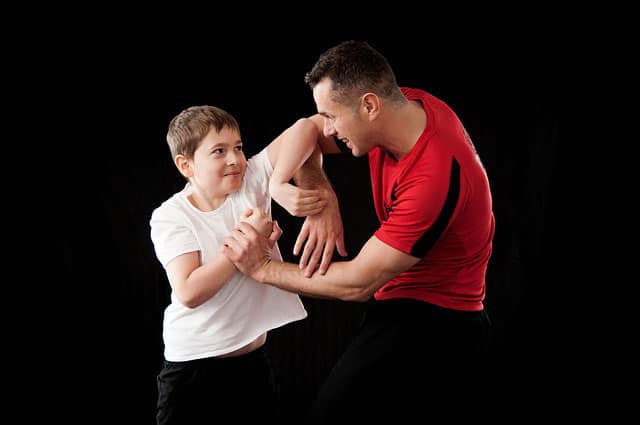
Of course, being able to know how to throw a punch is a far different task than being able to properly defend yourself. As such, it should almost go without saying that being able to defend yourself unarmed in a survival scenario includes many of the same general considerations when taking any action in a survival scenario. Specifically, in this instance, we are referring to the prerequisite that you be in good physical shape. This is especially important for self-defense because most people are unaware of how physically taxing a hand-to-hand fight actually is. If you are not prepared ahead of time, there is a real possibility that you could face a life and death situation that you cannot determine the outcome of.
You might also find interesting our article about the best martial arts for self-defense.
#2 Paracord
This definitely may seem like a bit of an odd choice, but chances are you are liable to have a length of paracord or any other type of woven rope on hand more so than other means of self-defense–outside of unarmed combat, of course. That said, it is vitally important that you understand that using a paracord or other rope for self-defense is not to be taken lightly or by someone who does not have training–unless it is an emergency reaction. This is because using paracord or rope in this way is technically a form of unarmed combat and you could be injured if you do not know what you are doing.

Still, it is likely a great idea to learn how to fight with a length of rope, keeping in mind that it is primarily a defense approach meant to trap and snare limbs–especially is those limbs happen to be holding a melee weapon at the time. One of the primary benefits of this is similar to fighting strictly with your hands: availability. To point, just as you are unlikely to find yourself without access to your hands and feet, so too are you unlikely to be found in a survival scenario without some strong length of rope–at least, if you are a dedicated reader and prepper of survival strategy.
#3 Pepper Spray
When it comes to non-lethal self-defense, traditional pepper spray is likely the bedrock of modern society due to the fact that it is not difficult to obtain–even in powerful concentrations–it acts as a solid deterrent and provides a distinct advantage for you at all future points in the conflict, and it is fairly plentiful. On top of that, you do not even necessarily need to be trained in using pepper spray to effectively do so, though you should definitely at least be familiar with the weapon to ensure that you do not accidentally spray yourself or another member of your party in the heat of the moment.
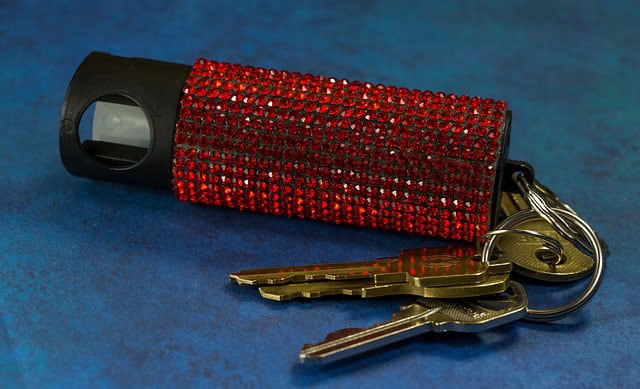
One thing to keep in mind is that pepper spray can be a bit hit or miss in terms of effectiveness–regardless of how accurate you are. This is because capsaicin relies on a chemical process as well as a subjective experience of pain to serve as a deterrent. However, nobody is identical to another person on the genetic level–even identical twins–which means that you cannot necessarily predict how effective pepper spray will be against a given assailant. As such, this can be an effective early means of self-defense, but make sure that you have something else more reliable to back it up in case the opponent is more resistant to capsaicin than others.
#4 Stun Weapon
While pepper sprays may be one of the most common non-lethal self-defense weapons, stun weapons are right along with them. However, stun weapons often have significantly more restrictions placed on them when used by civilians, so it may be a bit more difficult to get ahold of one that is also strong enough to incapacitate an intruder. That said, a stun weapon that is sufficiently powerful can be one of the most effective non-lethal self-defense weapons available, due in a large part to the fact that the body will respond to certain voltages with a fairly predictable reaction–though it should be noted that some people may be more resistant to electric shock than others, so always make sure you have a backup self-defense method if you use a stun weapon as your primary.
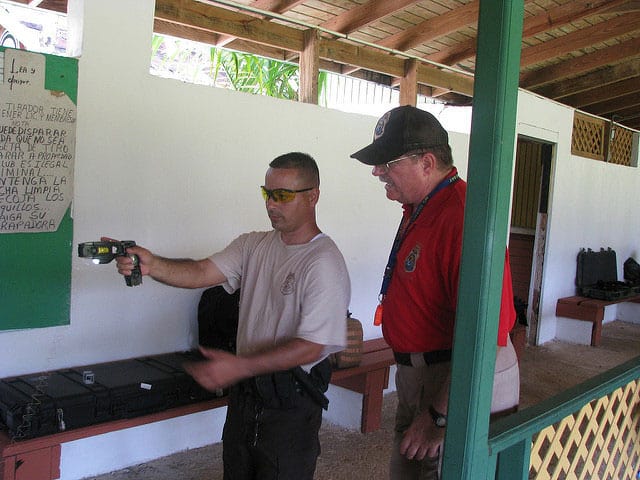
Specifically, if you get a strong enough stun weapon, there is a pretty good chance that your opponent will not only be incapacitated but left at your mercy. This is especially helpful in a situation where you are defending yourself from multiple assailants as a stun weapon can quite likely disable one assailant and leave you able to continue defending yourself from the others without too much concern. In fact, if you have a powerful enough stun weapon, you can even cause an involuntary release from the target which often precedes the end of the confrontation. On top of that, stun weapons can come in a variety of types and designs from stun guns to stun batons to the classic Taser.
#5 Rocksalt Gun
This is by far the closest thing on our list to a traditional firearm as it more or less is simply a slightly modified firearm that is instead designed to shoot non-lethal rounds. While it would be nice to use a firearm that fires rubber bullets for this purpose, those guns are a bit less common, a bit more expensive, and far less plentiful from an ammunition standpoint. Of course, you can also always just purchase rock salt shotgun shells and simply use your shotgun for self-defense with non-lethal ammunition. Regardless, a rock salt gun is an effective, yet non-lethal, means of defending yourself–though it definitely has some limitations.
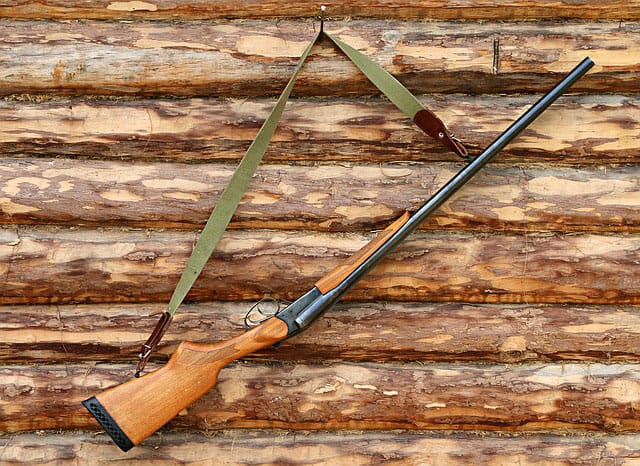
Specifically, rock salt ammunition does not have nearly the range of traditional ammunition due to the fact that the round is filled with pieces of rock salt as opposed to the metal shot commonly found. As such, a rock salt gun is definitely more of a close-combat self-defense measure–though, in fairness, most forms of non-lethal self-defense are. That said, rock salt guns have a bit of an advantage in some respects due to the fact that they have secondary deterrents built into their design. Specifically, the target will be hurt by simply being shot with the rock salt, but the salt will actually embed itself into the target’s wounds and provide a deep burning sensation.
#6 Club
As immortalized in Stanley Kubrick’s A Space Odyssey: 2001, this club is quite likely one of the first tools, and weapons, that humans learned how to use. Thankfully, a club remains just as viable a means of self-defense today as it did millennia ago, and even better, we have actually come a long way a civilization in terms of how we have refined the club. For instance, so long as an object carries enough weight, provides at least a nub of extension, and can handle the physical stress of impacting with another person, virtually any object can be used as a club of sorts.

That said, there are definitely some pieces of survival gear commonly found in a bug out bag that are far more likely to serve as an effective club than others, not to mention the fact that you can actively purchase dedicated and specialized clubs. Still, by far the most likely or common club most preppers are liable to carry is a flashlight. Granted, this will need to be one of those heavy Maglite flashlights to be suitable, but it ultimately provides solid versatility to an otherwise utilitarian tool. Another common type of club liable to be found in a bug out party is a walking stick, though you are going to want to make sure that the walking stick made of hardwood before you use it for self-defense.
#7 Dog
This one may be considered cheating to some people–especially depending on the breed and training of the dog in question. That said, a properly trained dog can arguably one of the most effective means of non-lethal self-defense–and even better, it is technically a form of self-defense that can be both lethal and non-lethal. Of course, this does mean that to be appreciably effective beyond a mere distraction that the dog will likely need to be fairly large–so no small dogs. This also means that untrained dogs are far less likely to provide a meaningful response as they are, at best, most likely to simply corner the opponent and wait for them to act–someone who likely has a weapon.

That said, if your dog is trained to attack on command and to attack with the intention of incapacitation as opposed to mortal damage, then it can serve as an excellent method of self-defense–potentially even superior to any means you could otherwise bring to bear. On top of how effective a properly trained dog can be for self-defense, there are plenty of benefits to keeping a survival dog around. Of course, this does once again go back to the dog’s training, so make sure that you keep up with that in terms of regularity and breadth. Still, a well-trained survival dog can assist in hunting and foraging as well as serve as an early alarm system, though that can be a bit breed dependent.
#8 Pepper Spray Gun
The difference between pepper spray and a pepper spray gun is more about delivery than active agent considering they both use some form of capsaicin to incapacitate their targets. Still, this structural difference is not at all insignificant, and using a pepper spray gun provides numerous advantages over simply using standard pepper spray. First, it is important to understand how the two differ. For pepper spray, the capsaicin is contained within a tube of pressurized and saturated fluid that is sprayed onto opponents–primarily the eyes to blind them. With a pepper spray gun, the effect is more similar to a rock salt gun whose ammunition just happens to also explode with capsaicin upon impact.

From a tactical perspective, this allows a pepper spray gun to provide advantages that are not available to simply pepper spray. One of the primary advantages that the gun delivery method provides is range, with a pepper spray gun often having a range of over 100’ with traditional pepper spray only providing about 10’ of range. Beyond the range, a pepper spray gun also provides some advantages to targeting considering you firing a high-velocity projectile as opposed to a stream of liquid chemicals. Finally, pepper spray guns provide the advantage of reloading, which is not a feat too terribly many canisters of basic pepper spray can provide.
#9 Slingshot
Yes, we are aware that a slingshot is commonly thought of as a child’s toy, but slings and slingshots have been used for millennia as self-defense weapons–just ask David after he felled Goliath. That said, there is a fairly big difference between a sling and a slingshot–with the former requiring significantly more practice to use effectively than the latter. Another thing to keep in mind is that if you are not properly trained on the slingshot, it is quite easy to accidentally turn this non-lethal weapon into a leather weapon–especially if you have a tendency to use one of the most popular forms of ammunition for a slingshot: ball bearings.
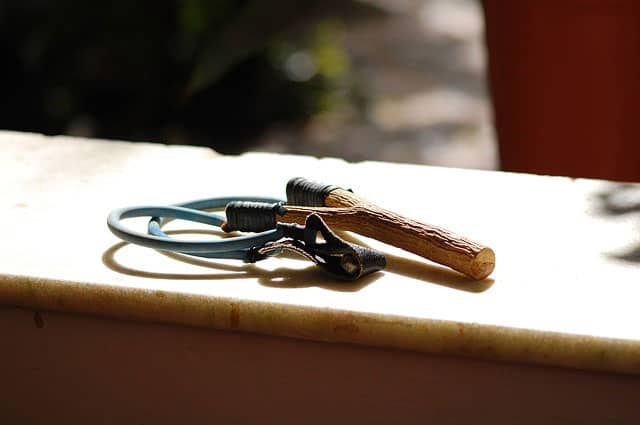
Of course, one of the primary benefits of a slingshot is that you do not need to worry about ammunition so long as you have access to large enough rocks. This means that deserts and marshlands are likely not a great setting for a slingshot, but most other regions will have a large enough supply of stones to keep you topped off forever. Beyond the on-hand ammunition, slingshots also have the advantage that they do not make too terribly much noise. While this is great for self-defense purposes–especially if you are facing off against multiple intruders–it is also great for hunting too.
#10 Alarm
People often forget that alarms work on a fairly common sense principle: noise will attract other people who, if they happen to be allies, will aid you in your self-defense. That said, you can even use alarms as a means of psychological warfare, making the enemy believe that you have reinforcements even if you do not. Keep in mind, your opponent knows as little about you as you do about him, so the possibility that you might have backup has to be a real option to this individual unless they have been casing your location for long enough to figure out the party composition as well as the schedule or routine of the individual members.

Also, when we say “alarm,” we do not necessarily mean a traditional home alarm that is used to alert you to the presence of an uninvited individual. Technically, an alarm is anything that will bring attention to your position–especially if you and your party have devised a warning signal ahead of time. In this instance, a whistle might be your best bet–especially if you have access to multiple tones as you can designate different tones for different purposes. Just remember that an alarm system should not be your only line of defense against intruders as a reliance on assumed behavior leaves you exposed to persistent opponents.
Conclusion
As we can see, there are plenty of approaches you can take with non-lethal self-defense–some of which even present a fairly easy transition if you do decide or need to use lethal force to defend yourself. Of course, it is always a good idea to keep as many means of self-defense on hand as is reasonable–especially since many of them either are pieces of gear or can be used as such. Regardless, it is important to remember that, whether lethal or not, any type of self-defense will require training or preparation, and having a non-lethal self-defense weapon will do you no good if you do not know how to properly use it in the given context.

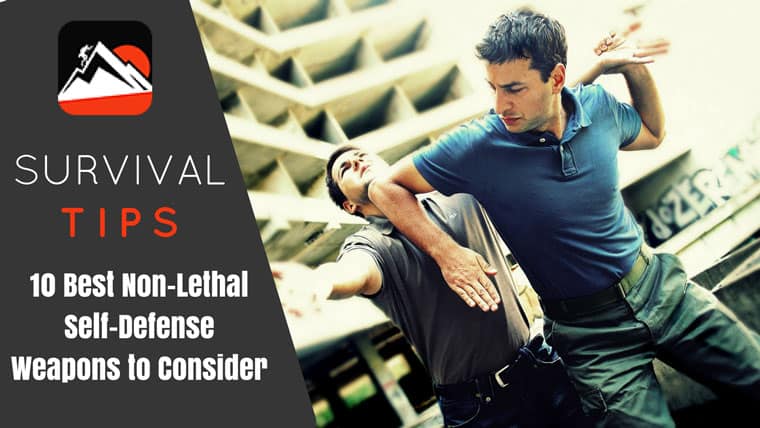

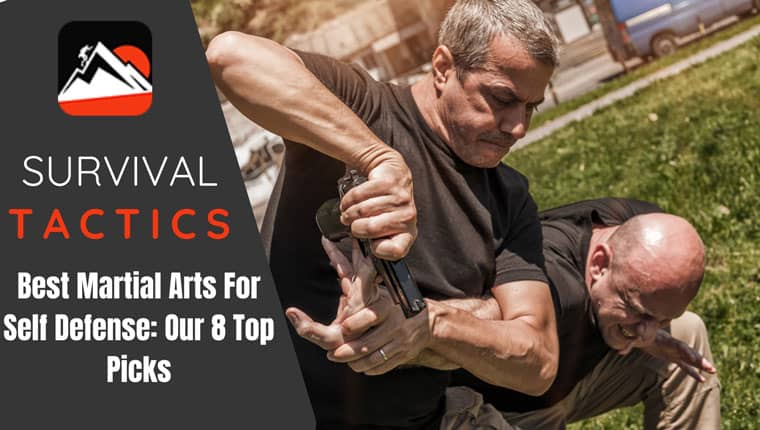

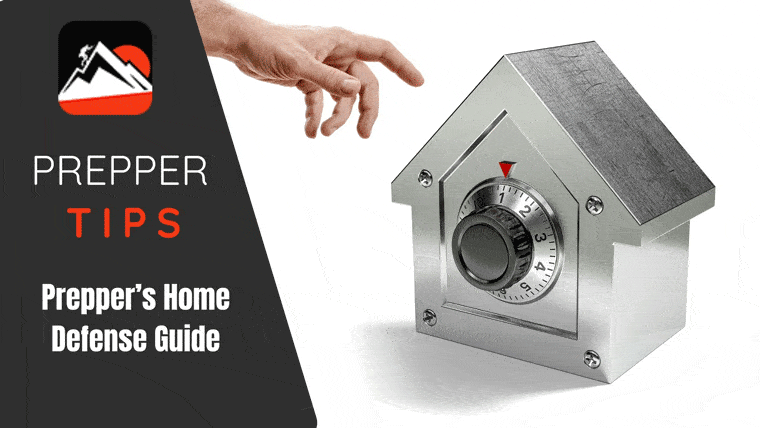
Wonderful and informative! I’d love to get a slingshot, but there is no place to practice 🙁 with anything. I live in an “old foggy” apartment – a tiny bit of outside space, some gardening but mostly for looking at.
I guess the pepper spray and gun would be my best options.